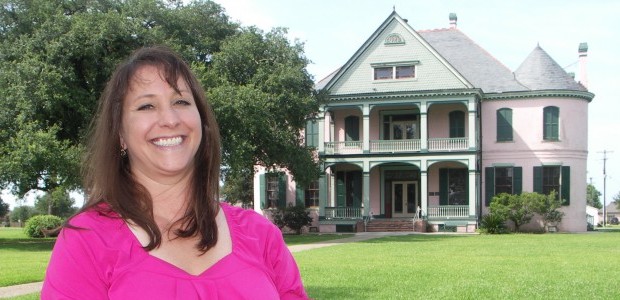Tropical Storm Warning discontinued for Tri-parish area
June 23, 2012
Larpenter returns to sheriff post
June 26, 2012Southdown Plantation is more than a 10,000 square foot pink brick and cypress mansion set on 4.6 acres of park-like property. Immediately noticed across Little Bayou Black by travelers and commuters along La. Highway 311, the 19th century facility, and 20th century developments surrounding it, contain both reminders of history and evidence of progress.
When Southdown hosts its open house Family Day from 1 to 5 p.m. on Saturday, the motive for this event will be more than simply offering food, music, entertainment activities, and free tours to visitors.
It is not simply about marking a 30th anniversary since the property – listed on the National Register of Historic Places in 1974 – was opened as a museum.
This festival is more than an invitation for the public to review, and re-learn an era when Terrebonne Parish was one of the nation’s top sugar cane producing and processing centers.
It is not even simply an opportunity to showcase what the facility has become in terms of being an active cultural center for the region.
For Southdown Executive Director Rachel Cherry, members of the Terrebonne Historical and Cultural Society and even descendants of the Minor family, that owned the plantation during its glory days, there are grander intentions.
They want the public to capture and share their vision. To recognize Southdown not only as a historic resource and contemporary gathering place for social events, but as a learning center and tourism draw with an eventual network of properties so the story of Antebellum mystique connects with contemporary industry.
Visits and Events
Southdown Plantation is being rediscovered by local residents as well as tourists. Cherry, who has been on the job for slightly more than three months, said this facility is already recognized as more than a place to display its impressive collection of artifacts.
“We are probably best known for the Southdown Marketplace which we host in spring and again in the fall,” Cherry said. “It is our main fundraiser and brings in approximately $80,000 [each time it is held]. But that is not much when you think about what it takes to maintain a 150-year-old building and property.”
Southdown also hosts the annual Ladybug Ball, concerts with the Louisiana Philharmonic Orchestra and other musical attractions from jazz brunches to Cajun concerts. Corporate events, such as the South Central Industrial Association’s annual crawfish boil, are held here. The Voice of the Wetlands Festival, Saints Sunday football parties, and other activities keep a full calendar of events available for participants.
The plantation is also a favorite location for wedding photos and receptions making use of a covered pavilion when weather demands it. “I would like to have a formal garden on the grounds,” THCS treasurer Paul Labat said. “A lot of plantations have formal gardens. People come here for photos and that would be great.”
“When the first group of people formed the [THCS] they decided to call it the historical and cultural society, just for the fact that they knew they would have entertaining events,” Cherry said.
Activities, tours and memberships offer the only constant source of revenue for Southdown Plantation. Supporters now say the time has come for this non-profit operation to expand to a new level.
Origins and Growth
Documenting the history of Southdown is not easy as records and recollections offer slightly varying dates for when events took place. Nevertheless, the spirit of telling the plantation’s story reveals hidden treasures regarding this facility and the region.
The earliest records regarding property that would become Southdown reveals that in 1821, Jim Bowie (yes, that Jim Bowie) and his brother, Rezin, purchased the land under consideration from Cuban owners, who had acquired it through a series of land grants dating back to 1790.
The Bowie brothers intended to build an indigo plantation one year before the official formation of Terrebonne Parish. By 1828, their investments and interests had changed. The brothers then sold 1,028 acres, including their home, which is believed to have been located approximately where the USDA sugar cane research center stands, to William J. Minor.
“The particular history of the Minor family is interesting,” Cherry said. “Watching that family travel [from England] to the United States, settle in Connecticut then go to Pennsylvania and eventually come down here is fascinating.”
Adding the Terrebonne property to a list of real estate they already owned, the Minor family first raised sheep locally, constituting the name Southdown after the breed of livestock. They then transitioned into growing and processing sugar cane.
The existing Southdown Plantation main house started as a one-story Greek Revival style home built by Minor in 1859. The second floor, and structural remodeling to its familiar Victorian style, was undertaken by Minor’s son, Harvey, in 1893.
As was common during most of the 19th century, this wealthy, agricultural family owned slaves, but according to local historians, the Minor’s treated their servants more humanely than many southern slaveholders.
Even into the 20th century, former slave cabins, later called workers quarters following the abolishment of slavery, were documented as standing in an area that is now the affluent Glenn Oaks neighborhood at Little Bayou Black and Polk Street. The quarters housed many sugar mill workers, descendants of slaves, more than 100 years after their families were declared free.
The sole reminder of slavery related to the plantation is the Southdown Cemetery, next to the Terrebonne Parish Library across from the USDA center. Marked graves identify the descendants of slaves, but it is not known how many unmarked plots are forever hidden, along with the stories of those individuals that toiled to build Southdown Plantation.
Sugar Mill Memories
The first on-site sugar mill at Southdown was built in 1846. From there processing, research and development, in addition to growing sugar cane, became a focal point for the next 130 years.
During the early 20th century, the Minors, having merged by marriage with the families of David Pipes and Conrad Krumhbarr added satellite plantations at Concord, Mandalay, Hollywood, Greenwood and Oak Forest to their growing venture.
At its zenith, Southdown Plantation consisted of 22,000 acres, more than 34 square miles, but while 86 mills processed the crop for the region only 9,000 acres of Southdown itself was used for actual growing of sugar cane.
During the 1920’s scientists at Southdown Plantation were credited with saving the Louisiana sugar industry by propagating a sugar cane variety resistant to mosaic disease.
With a major on-site sugar mill in full operation and multiple satellite farms, the Minor family business evolved and in 1932 Southdown ownership shifted to a corporate model. The Minor family moved out of their home in 1936.
“It was a wonderful life,” Margaret Minor Shaffer, 72, said she was told by her mother, Margaret Minor Krumhbarr, about growing up living at Southdown Plantation. Shaffer said Southdown’s success involved scientific research involving sugar care. “We grew all the experiment stations,” she said.
Prosper Toups Jr., 75, was 13 when his father, Prosper Toups Sr., who began working with Southdown Realty Operators in 1933, changed from being overseer of the Greenwood Plantation and moved to the main Southdown Plantation in 1950 to be overseer there. The senior Toups remained on the job at Southdown until his retirement in 1972.
Prosper Toups Jr. said sugar was transported to Southdown sugar mill by barge on Little Bayou Black and by narrow gage rail. A replica of a rail bridge is now a footbridge crossing the bayou from Veterans Park to Southdown. The massive complex operated day and night and during the height of processing season would employ up to 150 people.
“Over the years as transportation became better, [satellite] mills were all shut down and all the sugar went to Southdown,” Toups Jr. said. “We weren’t really allowed to walk around [inside Southdown], but every once in a while we could see what they had.”
Toups Jr. said that during the years the mill was in operation, some company executives and their families lived in the main house. His family was not among those residing there.
As the oil and gas industry boomed in Terrebonne Parish and federal regulations changed the sugar processing business, it became apparent that Southdown’s mill working days were numbered.
In March 1978, the Southdown sugar mill closed. The next year, its main factory was dismantled and sold to a company that rebuilt it Guatemala.
While the plantation’s main house and immediate acreage had been donated to the THCS in July 1975, it was not until after the mill closed and surrounding land was sold for real estate developments, that the one-time home began its transformation into a museum and cultural center.
Antiquity to Opportunity
Brenda Smith moved to Houma from Mexico, Mo., in 2008. Last week her son Rick Smith, his wife, Lisa, and children, Peyton and Abigail, were visiting from Missouri and Brenda Smith took them to see Southdown Plantation.
“It is neat for the kids to experience different places,” Brenda Smith said. “I want them to take away the historical factors of the plantation homes and understand how it does relate to today.”
Lee Shaffer III, nephew of Margaret Minor Shaffer, resides at Ardoyne Plantation, north of Bull Run Road on La. Highway 311. While he hopes to get that house restored to a level that it can be open to the public, he has a fondness for Southdown and envisions grander plans for area plantations that are clinging to pieces of their past.
“I would like to see a tour of all the area plantations including Southdown, Ardoyne and others,” Shaffer said. “You could go from one to another in Terrebonne and Lafourche parishes, and it could help them all.”
“We could have a history speaker and reception,” Cherry said regarding new ideas for Southdown. “That brings the community together.” Toups added that he likes the idea of having actors portray historic figures for future Southdown events.
THCS members have been talking about expanding events and even seeking corporate sponsorships to not only pay the bills, but expand Southdown’s exposure.
“The best way [to market Southdown] is to be diverse,” Cherry said. “That way you open many avenues to people.”
“That is part of the reason we are having this Family Day,” Labat said. “We want to bring young people together to see how beautiful it is and what it has to offer.”
“[Promoting Southdown] is a little different now than it has been in the past,” Cherry continued. “Of course we want to keep the events. I’m starting to write curriculum that we hope to get approved by the school board. Teachers can use it so the kids going by don’t just say, ‘Hey, there is that big house again.’ We want them to say, ‘I learned about that in school.’ Then the moms and dads gain awareness, too.”
Reserving a place for expanded events and revenue is the $650,000 Southdown Pavilion that was built in 2004. The structure is 80 wide by 150 long and can be rented for multiple functions.
With the addition of other buildings and contents for display, Southdown Plantation preserves not only artifacts from the Antebellum age, but features industrial and cultural contributions from the region to the nation. Display rooms are dedicated to local industry, Mardi Gras celebrations, artists, writers and the rebuilt office of Sen. Allen J. Ellender hold a surprising draw of public attention.
“If places like Southdown are not supported by the community they are going to go away,” Labat said.
Lasting Color
The big question still connected to Southdown’s past, present and future remains: Why is the main house painted pink?
Following the Civil War, the South laid in financial ruin. Once proud and wealthy families had to drastically change lifestyles from what they had become accustom. This included cutting costs associated with painting their homes.
Those that remember Southdown as a white building when the sugar mill was in operation, were surprised in 1975 when a paint chip analysis revealed that sometime, more than a century before sugar processing would end at this location, the main house had been painted pink – or some variation of red which had faded years before new coats of white were added to conceal the color.
The reason, according to Lee Shaffer III, was because pigments used to make red paint were the least expensive in the 1860s. The notion of using red (generally associated with the color of barns), or a blended version that came out pink, would be a mark of embarrassment and shame to affluent people of the 19th Century.
Some remaining Minor family members rejected the notion that their home had ever been anything but white. “I remember my grandmother would argue, ‘It was never pink,’” Shaffer said. “Personally, I’m glad they restored it to pink. It makes it stand out.”
Three months on the job, Southdown Plantation Executive Director Rachel Cherry says her business marketing skills and knowledge of history will generate a new level of attention to the Terrebonne Parish attraction. Southdown Plantation will host its 30th anniversary celebration with a public Family Day Open House from 1 to 5 p.m. on Saturday.















